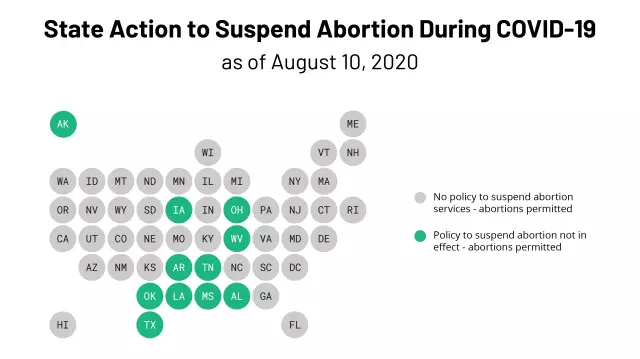- Author Rachel Wainwright [email protected].
- Public 2023-12-15 07:39.
- Last modified 2025-11-02 20:14.
How to determine if there was an abortion?
An abortion performed by any method is a medical intervention, and, accordingly, can lead to various kinds of complications.

In some cases, they appear immediately, and sometimes after a long time.
When examining or during the next pregnancy, the gynecologist must be warned about whether there was an abortion. This will help him monitor pregnancy and prevent the development of possible complications in time.
Types of abortions and possible complications for a woman's health
Abortion is dangerous not only with physiological complications, but also with psychological trauma that can remain for life. Quite often, even if there was an abortion for medical reasons, a woman has a feeling of guilt and a desire to hide this fact. Also, a desire to hide the fact of an abortion may arise if a woman creates a new family and it seems to her that her husband may not understand her and condemn her. Therefore, the question often arises whether the doctor can determine whether there was an abortion, and by what signs.
However, the danger lies not in the fact that the doctor will be able to identify a previously carried out abortion, but in possible complications that may not appear immediately, but after many months.
Regardless of whether the abortion was carried out for medical reasons or not, the arising violations from many body systems can be more or less significant and are largely determined by the chosen method of termination of pregnancy.
Medical abortion is considered the safest for a woman's health. It is done early (usually up to 6-7 weeks) with drugs that induce miscarriage. If the procedure was successful, then usually after a while, almost no doctor will be able to determine whether there was an abortion, since there is no mechanical damage to the genitals.
However, in some cases, after the termination of pregnancy, indigestion (vomiting, nausea), minor abdominal pain, fever, chills and uterine bleeding may occur. These and other symptoms can be caused by a variety of reasons, from hormonal disruptions to incomplete interruption, when small parts of the fetus or placenta remain in the uterine cavity. Therefore, if they occur, it is necessary to consult a gynecologist. After conducting additional research, he will determine whether there was an abortion, as well as further actions, since in some cases surgery may be required.
After a vacuum abortion, a gynecologist is most often contacted due to menstrual irregularities. But the most dangerous is the surgical termination of pregnancy, during which mechanical damage to the uterus and other organs is possible. During the next pregnancy, the observing physician should be sure to inform about whether there was an abortion, which will significantly increase the likelihood of its favorable course.
When to contact a gynecologist after an abortion
After a surgical abortion for a week, spotting is the norm. However, if they contain impurities with an unusual odor, this may indicate the beginning of the development of infection. In addition, if the amount of blood loss exceeds normal, this may mean that an incomplete abortion has occurred. In this case, you should urgently contact a gynecologist after an abortion in order to carry out the necessary therapy on time.
In addition to early complications that arise soon after an abortion, other negative processes that can affect a woman's health quite often develop. Among them are the occurrence of adhesions, hormonal disorders, chronic inflammatory diseases and dysfunctions of the organs of the reproductive system. Usually, when these complications arise, it is dangerous to hide from the doctor whether there was an abortion, since this delays the time of making the correct diagnosis.
After an abortion for medical reasons or for other reasons, hormonal and physiological changes occur, which can affect a new pregnancy. The main causes of menstrual irregularities after an abortion are:
-
Removal of the mucous layer with damage to the deeper layers of the inner surface of the uterus. The subsequent growth of the endometrium is uneven, which can cause meager or, on the contrary, abundant and painful periods. This usually does not occur after medical abortion;

Terms of abortion for medical reasons - Hormonal disruption that causes malfunction of the ovaries. The resulting dysfunction can contribute to the occurrence of other complications: uterine fibroids, endometriosis, endometrial polyps, polycystic ovary, adenomyosis.
Rehabilitation and recovery after abortion for medical reasons and other reasons
After an abortion, the gynecologist must determine measures to reduce the risk of subsequent complications. The length of the recovery period depends on the woman's age, her health status, the presence of children and the number of abortions suffered earlier.
Medical rehabilitation after termination of pregnancy usually includes antibiotic medication. Sometimes hormonal medications are required to restore the background.
The recovery process accelerates 2-3 weeks of abstinence from sex. During this time, the damaged inner surface of the uterus is restored, which reduces the likelihood of developing infectious diseases. Also, during this period, you should avoid physical activity and swimming in the pool or sea.
A new pregnancy should be planned no earlier than six months later. At the same time, when consulting, the doctor should be informed about whether there was an abortion, which will increase the chances of an easy pregnancy and the birth of a healthy baby.
Found a mistake in the text? Select it and press Ctrl + Enter.






